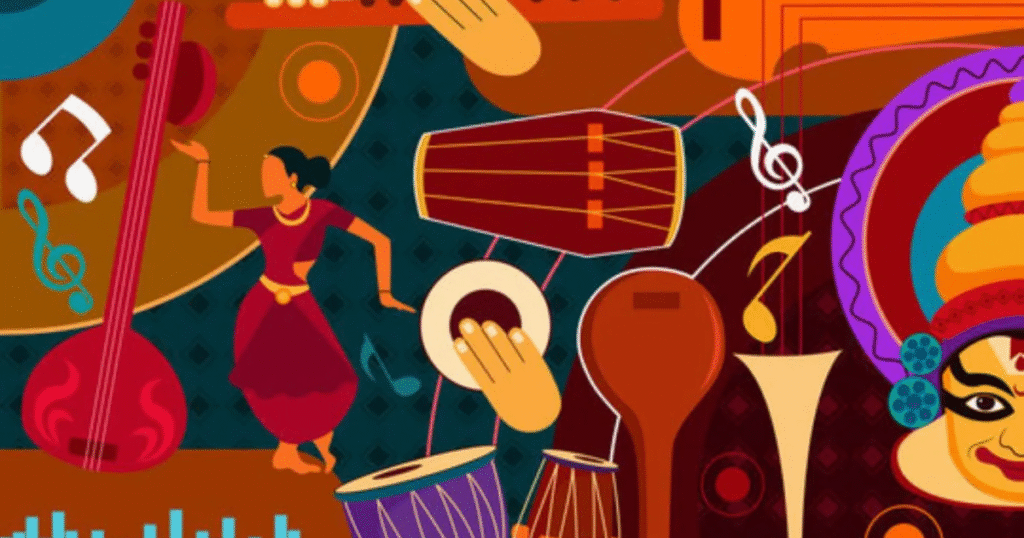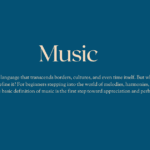Music is a universal language that transcends borders, cultures, and even time itself. But what exactly is music? How do we define it? For beginners stepping into the world of melodies, harmonies, and rhythms, understanding the basic definition of music is the first step toward appreciation and perhaps even creation.
What Is Music Definition?
The Basic Definition
Music is defined as an organized combination of sounds and silences that expresses emotions, ideas, or stories. It typically includes elements such as rhythm, melody, harmony, and timbre. At its core, music is sound arranged in a way that is pleasing or meaningful to the listener.
The Etymology of the Word “Music”
The word “music” originates from the Greek word “mousike,” which referred to the art of the Muses—goddesses who inspired literature, science, and the arts in Greek mythology. Over time, the term evolved to focus specifically on the auditory arts.
Elements of Music
Understanding music means becoming familiar with its core components. These elements are the building blocks that help in creating various forms of musical expression.
Rhythm
Rhythm is the pattern of sounds and silences in time. It forms the temporal aspect of music. Think of the beat in a song that makes you tap your feet—that’s rhythm at work.
Melody
Melody is a sequence of musical notes that are perceived as a single entity. It’s the part of the music that you often find yourself humming.
Harmony
Harmony occurs when two or more notes are played together to produce a pleasing sound. It adds richness and depth to the music.
Timbre (Tone Color)
Timbre is what makes one instrument sound different from another, even if they’re playing the same note. It’s the unique quality of sound.
Dynamics
Dynamics refer to the volume of the music—how loud or soft it is. They help convey emotion and intensity.
Tempo
Tempo is the speed at which a piece of music is played. It can be fast, slow, or somewhere in between.
Form
Form is the structure of a musical composition—how it’s organized from beginning to end. Common forms include binary (AB), ternary (ABA), and rondo (ABACA).
Different Types of Music

Music comes in many forms and styles. Here are a few popular categories:
Classical Music
This is often associated with orchestras and composers like Beethoven or Mozart. It’s characterized by complex structures and rich harmonies.
Pop Music
Pop music is designed to appeal to a broad audience. It’s catchy, usually short in length, and often features repetitive structures.
Rock Music
Rock music often includes electric guitars, strong rhythms, and powerful vocals. It originated in the mid-20th century and has many subgenres.
Jazz
Jazz is known for its improvisational style and complex harmonies. It originated in the African-American communities of the early 20th century.
Hip-Hop
Hip-hop is a cultural movement that includes rap music, DJing, breakdancing, and graffiti art. The music is often rhythmic and includes spoken lyrics.
Electronic Music
Produced using electronic instruments and technology, this genre includes styles like techno, house, and trance.
Folk and Traditional Music
These styles are deeply rooted in culture and tradition. They often tell stories or preserve historical events and customs.
How Music Affects Us

Emotional Impact
Music can make you feel happy, sad, energized, or relaxed. It’s often used in films and events to evoke emotions.
Cognitive Benefits
Listening to and learning music can enhance memory, attention, and problem-solving skills. It’s even used in some forms of therapy.
Physical Effects
Music can also influence physical states. Fast-paced music can increase heart rate and energy, while slow music can aid relaxation.
Social Connection
Music brings people together through concerts, festivals, and community events. It’s a tool for social bonding and cultural expression.
Learning Music as a Beginner
Instruments vs. Vocal
Beginners often start by choosing whether to learn a musical instrument or focus on singing. Each path offers unique benefits.
Reading Music
Musical notation is a system that represents musical sounds using symbols. Learning to read sheet music can help you understand and perform more effectively.
Online and Offline Resources
From video tutorials and mobile apps to local music schools, there are many resources available to help beginners learn music at their own pace.
Practice and Patience
Learning music requires consistent practice and patience. Start with simple exercises and gradually move to complex compositions.
Music Theory Basics
Scales
Scales are a series of notes ordered by pitch. The most common scales are major and minor.
Chords
Chords are combinations of three or more notes played simultaneously. They form the harmony in music.
Intervals
An interval is the distance between two notes. Understanding intervals helps in constructing scales and chords.
Key Signatures
A key signature tells you the key in which a piece of music is written, influencing which notes are sharp or flat.
Music in Culture and Society

Cultural Identity
Music often reflects the values, beliefs, and history of a culture. It plays a key role in ceremonies, celebrations, and rituals.
Political and Social Messages
Throughout history, music has been used to protest, inspire change, and raise awareness about social issues.
Entertainment
Music is a cornerstone of the entertainment industry, appearing in movies, television, and live performances.
Technology and Music
Digital Production
Modern music is often created using software and digital audio workstations (DAWs), making music production more accessible.
Streaming Services
Services allow people to access vast libraries of music instantly, changing how we listen and discover new artists.
Music and AI
Artificial Intelligence is increasingly being used to compose, arrange, and even perform music, opening new frontiers in creativity.
Why Learn Music?
Personal Fulfillment
Making music can be a deeply satisfying experience, providing a sense of achievement and joy.
Academic and Career Opportunities
Music education can lead to careers in teaching, performance, composition, and audio engineering.
Lifelong Enjoyment
Whether you pursue it professionally or as a hobby, music can enrich your life in countless ways.
Also Read : Mastering Music Performance: Tips From The Pros
Conclusion
Music is more than just sound—it’s an expression of the human spirit, a vehicle for emotion, and a tool for communication. For beginners, understanding the basic definition of music opens the door to a lifelong journey of learning and enjoyment. With its many forms, elements, and impacts, music touches every corner of human life and culture.
FAQs
1. What is the simplest definition of music?
Music is organized sound that is pleasing or meaningful to the listener, usually involving rhythm, melody, and harmony.
2. Can anyone learn music?
Yes, anyone with interest and dedication can learn music. It’s a skill that can be developed over time.
3. Do I need to know how to read sheet music to play an instrument?
While reading music is helpful, it’s not strictly necessary. Many musicians learn by ear or use chord charts.
4. What’s the best instrument for beginners?
Keyboard, guitar, and recorder are often recommended for beginners due to their simplicity and affordability.
5. How long does it take to learn music?
The timeline varies based on your goals and practice routine. Basic proficiency can take a few months, while mastery takes years.




